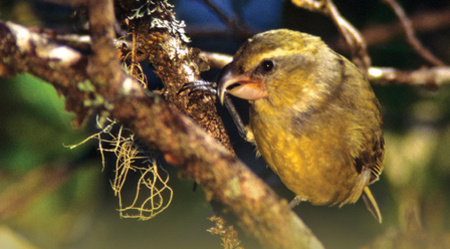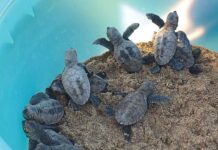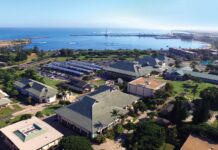By Jason Hilford
 Hanawi Natural Area Reserve is a small surviving piece of Maui’s past. Spanning 7,500 acres on Haleakala volcano’s virtually inaccessible northeastern slope, the reserve is a time capsule of what our island used to be: pristine, remote, and full of life. Hanawi is home to one of Maui’s last stands of native forest, which supports a diverse network of island fauna. In this and other wet woodlands on windward Maui, the struggling remnants of our island’s embattled bird population hang on against seemingly insurmountable odds.
Hanawi Natural Area Reserve is a small surviving piece of Maui’s past. Spanning 7,500 acres on Haleakala volcano’s virtually inaccessible northeastern slope, the reserve is a time capsule of what our island used to be: pristine, remote, and full of life. Hanawi is home to one of Maui’s last stands of native forest, which supports a diverse network of island fauna. In this and other wet woodlands on windward Maui, the struggling remnants of our island’s embattled bird population hang on against seemingly insurmountable odds.
Since January, however, this region has been the migratory home for a slightly more earthbound species: a hardy group of biologists hoping to effect an 11th-hour rescue for the forest’s feathered inhabitants. Temporarily employed as research assistants by the Maui Forest Bird Recovery Project, an Olinda-based research organization, this itinerant group has converged on Maui for a 20-week assignment researching birds that live nowhere else in the world, with the ultimate goal of helping prevent their extinction.
The Maui Forest Bird Recovery Project was established in 1997 through a cooperative agreement between the United States Fish and Wildlife Service and the Hawai‘i Department of Land and Natural Resources, and was a direct response to Maui’s continued loss of native forest birds—specifically the po‘ouli (dark-headed honeycreeper), whose numbers had dropped to single digits. Although the project functions under the auspices of the
University of Hawai‘i, the organization receives federal, state, and private funding. Field teams locate, identify, and ultimately count individuals, observing them with telescopes and video monitors and noting behavior and breeding patterns. “They’re a proactive group of intelligent people who have given hope to a situation that was fairly desperate,” says DLNR biologist Art Medeiros.
For weeks at a time, these dedicated individuals endure cold and rainy weather (Hanawi soaks up an average of 350 inches of rain a year), traversing terrain so rugged, they have to be helicoptered in and out. “It’s the most remote field site I’ve ever worked in,” says research assistant Hanna Mounce. “It’s also the most incredible.”
Remoteness is a requisite to studying Hawai‘i’s endemic bird populations. “Most of Maui’s native birds live above 5,000 feet,” says Project Coordinator Kirsty Swinnerton, whose job began in 2003. “The birds you see in your backyard are almost all introduced.” The native birds have been gradually pushed up Haleakala’s slopes by an array of threats ranging from development to predators to diseases. Of the14 honeycreeper species known from Maui County in recent times, only 6 remain, 2 of which are endangered and the project is working to save. The po‘ouli may already be extinct; the last known individual died in captivity in 2004.
To understand the work of the Maui Forest Bird Recovery Project, consider its efforts on behalf of a colorful little bird called the Maui parrotbill. Living only on the island from which it takes its name, the bird stands about five inches tall with vivid yellow-green plumage and a sharp, curved beak resembling that of a parrot (hence the second half of its name); Swinnerton fondly describes it as “a very charismatic bird.”
It’s been 20 years since the parrotbill population was tallied—at somewhere between 270 and 730 birds. Swinnerton anticipates that the team will uncover details about the bird leading to a more accurate count. But with populations this small, the precise mathematical techniques usually employed in bird counts simply don’t work. “To understand whether the population is declining or not, we need to identify individual birds, which requires banding them, and then make repeated observations over a period of several years,” she says.
A census is only one answer to the countless questions science has about the Maui parrotbill; the bird now thought to be Maui’s rarest remains, largely, a mystery. Even the bird’s daily behaviors are essentially unknown. “Our research amounts to focusing on a new species that’s been little studied before, and finding out what direction its conservation should go,” says Mounce.
“The goal of any research is to be predictive,” says Medeiros, stressing that conservation research helps determine whether present-day actions and expenditures are effective measures. “People tend to think that biologists have all the answers, but we don’t,” adds Swinnerton. “We try something and see if it works. If it doesn’t, we need to try something else.”
What little is known about the Maui parrotbill’s reproductive behavior paints a grim picture for its survival on modern-day Maui. Despite its charisma, the bird is not exactly a prolific breeder; female parrotbills lay only one egg at a time, and fledglings rely completely on their parents for up to eight months. And according to Swinnerton, most monitored nests have failed. This unusual combination of low natural birth rate and long dependence (which makes for a shorter propagation age) translates into extremely slow population growth.
Measured reproductive pace wasn’t a problem back when the parrotbill occupied a set niche in the dry koa forests that once flourished on leeward Maui. Ironically, the bird’s near-pinpoint adaptation to those trees is now a detriment. Parrotbills are specialist feeders, their diet limited to a small variety of native insects and grubs that inhabit koa. Even the bird’s beak has evolved to bore through the bark and break the branches of koa trees in search of food.
But the koa forests are all but gone now, choked out by habitat-altering invaders like eucalyptus, guava, and miconia. Introduced predators (rats, mongooses, feral cats) and mosquitoes carrying avian malaria have likewise driven the parrotbill population into wetter areas like Hanawi.
Forest restoration is taking some of the pressure off. Fences surround 2,000 acres of this avian diaspora, keeping out the feral goats and pigs that uproot trees and create devastating erosion—and preserving what Swinnerton calls “the crËme de la crËme of Maui’s remaining native forest.” Still, the parrotbill is not as suited to the wet forests as to the koa, and predators can still slip through fences. It’s not perfect, but for now, it’s all they have.
Despite the passion for her cause lurking just beneath her calm, British persona, Swinnerton maintains an even temperament when discussing bird conservation on Maui. “You really have to have a long-term view as a biologist,” she says. “Our interim goal is seeing what we can do to keep the populations steady, and large enough to take root when the dry forests are restored in 20, 40, 50 years.” She holds out hope that the parrotbill endeavor will reveal a few things about the ‘akohekohe, another endemic Maui bird, whose numbers have dipped to around 3,000—or even uncover a po‘ouli straggler or two.
In the face of daunting odds for Maui’s native birds, Swinnerton remains optimistic. “Forest protection is key,” she says, “but it’s not the only answer.” She points to her 14 years as a conservation biologist on Mauritius, a tiny island nation in the Indian Ocean, as an example. There, despite much greater habitat destruction, her captive-breeding and research team brought back three bird species from the verge of extinction. The Mauritius kestrel was down to a single breeding pair in the late ‘70s; today, there are 800 in the wild. “They have the same problems [in Mauritius] we have on Maui,” says Swinnerton, “but we’re approaching it with a much more large-scale idea. We really have a chance to make a difference here; it just takes time.”
Visit the MFBRP Web site at:
www.mauiforestbird.org




